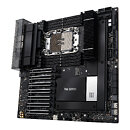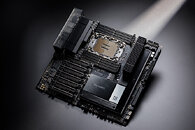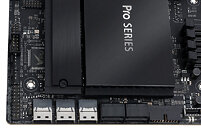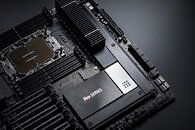TheLostSwede
News Editor
- Joined
- Nov 11, 2004
- Messages
- 17,769 (2.42/day)
- Location
- Sweden
| System Name | Overlord Mk MLI |
|---|---|
| Processor | AMD Ryzen 7 7800X3D |
| Motherboard | Gigabyte X670E Aorus Master |
| Cooling | Noctua NH-D15 SE with offsets |
| Memory | 32GB Team T-Create Expert DDR5 6000 MHz @ CL30-34-34-68 |
| Video Card(s) | Gainward GeForce RTX 4080 Phantom GS |
| Storage | 1TB Solidigm P44 Pro, 2 TB Corsair MP600 Pro, 2TB Kingston KC3000 |
| Display(s) | Acer XV272K LVbmiipruzx 4K@160Hz |
| Case | Fractal Design Torrent Compact |
| Audio Device(s) | Corsair Virtuoso SE |
| Power Supply | be quiet! Pure Power 12 M 850 W |
| Mouse | Logitech G502 Lightspeed |
| Keyboard | Corsair K70 Max |
| Software | Windows 10 Pro |
| Benchmark Scores | https://valid.x86.fr/yfsd9w |
Yes, you read that correctly, ASUS didn't launch just one, but two W790 based LGA-4677 motherboards today, namely the Pro WS W790-Sage SE and the Pro WS W790-Ace. The main difference here is that the Sage supports up to seven PCIe 5.0 x16 slots—one is a x8 slot electrically—and is designed for the Xeon W-3400 series, whereas the Ace supports five PCIe 5.0 x16 slots and is in turn designed for the Xeon W-2400 series. One downside of these boards is that they might not fit in a standard ATX case, as the Sage follows the SSI-EEB form factor and the Ace the SSI-CEB form factor, both of which are a fair bit wider than an ATX motherboard and with different mounting holes.
The Pro WS W790-ACE also sports eight DDR5 DIMM slots that operate in quad-channel and supports up to 2 TB of RAM if ECC R-DIMMs are used. Furthermore, ASUS has kitted out the Ace with a pair of PCIe 4.0 M.2 slots, one 2280 and one 22110 slot, four SATA ports, three slim SAS ports, a Marvell 10 Gbps and an Intel 2.5 Gbps Ethernet interface, a single USB 3.2 Gen 2x2 20 Gbps USB Type-C port around the back and an internal header for a second, case mounted port. Finally the board has four USB 3.2 Gen 2 10 Gbps Type-A ports around the back and a header for a further two., as well as eight USB 2.0 ports around the back and audio courtesy of a Realtek S1220A based solution with optical S/PDIF out.






The Pro WS W790-Sage SE, where SE stands for Special Edition, supports eight-channel memory over as many slots, but is still limited to 2 TB of RAM. Here, all the M.2 slots are of the 22110 variety and two of the three slots support PCIe 5.0, while the third one is PCIe 4.0. The SATA ports have gone from four to eight, but the SAS ports have been reduced to two from three. ASUS has also added dual 10 Gbps Ethernet ports powered by Intel hardware, as well as an M.2 slot for an optional Wi-Fi module. Gone is support for a case mounted 20 Gbps USB-C port, in favour of a 10 Gbps one, although the rear of the board gets an additional USB-C port, even though it's only at 10 Gbps, while all but two USB 2.0 ports remain. Here, ASUS has also added an Aspeed AST2600 remote management controller, with its own dedicated Ethernet and VGA port.
ASUS didn't provide any pricing for the new boards and neither model is showing up on the ASUS website at the time of this news post going live.
View at TechPowerUp Main Site | Source
The Pro WS W790-ACE also sports eight DDR5 DIMM slots that operate in quad-channel and supports up to 2 TB of RAM if ECC R-DIMMs are used. Furthermore, ASUS has kitted out the Ace with a pair of PCIe 4.0 M.2 slots, one 2280 and one 22110 slot, four SATA ports, three slim SAS ports, a Marvell 10 Gbps and an Intel 2.5 Gbps Ethernet interface, a single USB 3.2 Gen 2x2 20 Gbps USB Type-C port around the back and an internal header for a second, case mounted port. Finally the board has four USB 3.2 Gen 2 10 Gbps Type-A ports around the back and a header for a further two., as well as eight USB 2.0 ports around the back and audio courtesy of a Realtek S1220A based solution with optical S/PDIF out.






The Pro WS W790-Sage SE, where SE stands for Special Edition, supports eight-channel memory over as many slots, but is still limited to 2 TB of RAM. Here, all the M.2 slots are of the 22110 variety and two of the three slots support PCIe 5.0, while the third one is PCIe 4.0. The SATA ports have gone from four to eight, but the SAS ports have been reduced to two from three. ASUS has also added dual 10 Gbps Ethernet ports powered by Intel hardware, as well as an M.2 slot for an optional Wi-Fi module. Gone is support for a case mounted 20 Gbps USB-C port, in favour of a 10 Gbps one, although the rear of the board gets an additional USB-C port, even though it's only at 10 Gbps, while all but two USB 2.0 ports remain. Here, ASUS has also added an Aspeed AST2600 remote management controller, with its own dedicated Ethernet and VGA port.
ASUS didn't provide any pricing for the new boards and neither model is showing up on the ASUS website at the time of this news post going live.
View at TechPowerUp Main Site | Source






